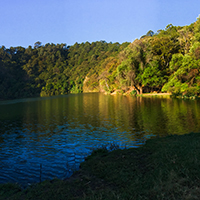Seasonal variation of Microcystis aeruginosa and factors related to blooms in a deep warm monomictic lake in Mexico

Accepted: 23 April 2021
Supplementary: 91
HTML: 21
All claims expressed in this article are solely those of the authors and do not necessarily represent those of their affiliated organizations, or those of the publisher, the editors and the reviewers. Any product that may be evaluated in this article or claim that may be made by its manufacturer is not guaranteed or endorsed by the publisher.
Authors
The occurrence of cyanobacterial blooms has increased globally over the last decades, with the combined effect of climate change and eutrophication as its main drivers. The seasonal dynamic of cyanobacterial blooms is a well-known phenomenon in lakes and reservoirs in temperate zones. Nevertheless, in the tropics, most studies have been performed in shallow and artificial lakes; therefore, the seasonal dynamic of cyanobacterial blooms in deep and eutrophic tropical lakes is still under research. We studied the seasonal variation of the phytoplankton community and the factors associated with Microcystis aeruginosa blooms along the water column of Lake Alberca de Tacámbaro, a warm monomictic crater lake located in Mexico, during 2018 and 2019. According to previous studies performed in 2006 and 2010, this lake was mesotrophic-eutrophic, with Chlorophyta and Bacillariophyta as the dominant groups of the phytoplankton community. During 2018 and 2019, the lake was eutrophic and occasionally, hypertrophic, a phenomenon likely associated with the increase of farmland area around the lake. The dominant species was M. aeruginosa, forming blooms from the surface to 10 m depth in winter, in the hypolimnion in spring and summer, and along the full water column in autumn. These findings suggest that M. aeruginosa in Lake Alberca de Tacámbaro displays seasonal and spatial population dynamics. Total phosphorus, dissolved inorganic nitrogen, water temperature and photosynthetically active radiation were the environmental factors related to M. aeruginosa blooms. Our results suggest that the changes in the structure of the phytoplankton community through time, and M. aeruginosa blooms in Lake Alberca de Tacámbaro, are mainly related to changes in land use from forest to farmland in areas adjacent to the lake, which promoted its eutrophication in the last years through runoffs. Comparative studies with other deep and eutrophic lakes will allow us to gain a deeper understanding of the dynamic of cyanobacterial blooms in natural and artificial water reservoirs strongly stressed by human activities.
Edited by
Diego Fontaneto, CNR-IRSA Water Research Institute, Verbania, ItalyHow to Cite

This work is licensed under a Creative Commons Attribution-NonCommercial 4.0 International License.
Similar Articles
- Emanuel BRAIG, Gerhard WELZL, Willibald STICHLER, Uta RAEDER, Arnulf MELZER, Entrainment, annual circulation and groundwater inflow in a chain of lakes as inferred by stable 18O isotopic signatures in the water column , Journal of Limnology: Vol. 69 No. 2 (2010)
- Walter AMBROSETTI, Luigi BARBANTI, Nicoletta SALA, Residence time and physical processes in lakes , Journal of Limnology: Vol. 62 No. s1 (2003): Residence Time in Lakes: Science, Management, Education
- Claudio A. BELIS, Daniel ARIZTEGUI, The influence of biological and environmental factors on the stable isotopic composition of ostracods – the Late Pleistocene record from Lake Albano, Central Italy , Journal of Limnology: Vol. 63 No. 2 (2004)
- Sebastian Lenz, Uta Raeder, Juergen Geist, Representative monitoring of the calcifying alga Phacotus lenticularis (Chlamydophyceae) in lentic ecosystems , Journal of Limnology: Vol. 79 No. 2 (2020)
- Alessandro LUDOVISI, Elda GAINO, Meteorological and water quality changes in Lake Trasimeno (Umbria, Italy) during the last fifty years , Journal of Limnology: Vol. 69 No. 1 (2010)
- Mariko Nagano, Hideyuki Doi, Degree of high phenotypic plasticity in wild populations of Daphnia in early spring , Journal of Limnology: Vol. 77 No. 2 (2018)
- Kay Van Damme, Supiyanit Maiphae, Phannee Sa-Ardrit, Inland swamps in South East Asia harbour hidden cladoceran diversities: species richness and the description of new paludal Chydoridae (Crustacea: Branchiopoda: Cladocera) from Southern Thailand , Journal of Limnology: Vol. 72 No. s2 (2013): Freshwater Invertebrates of Southeast Asia
- Anna VISCONTI, Marina MANCA, The invasive appearance of Eudiaptomus gracilis (G.O. Sars 1863) in Lago Maggiore , Journal of Limnology: Vol. 69 No. 2 (2010)
- Valeria Rossi, Catia Maurone, Giorgio Benassi, Ireneo Ferrari, Reproduction of Daphnia pulex in a Northern Italy pond , Journal of Limnology: Vol. 73 No. 3 (2014)
- Sameer M. Padhye, Neelesh Dahanukar, Distribution and assemblages of large branchiopods (Crustacea: Branchiopoda) of northern Western Ghats, India , Journal of Limnology: Vol. 74 No. 2 (2015)
<< < 49 50 51 52 53 54 55 56 57 58 > >>
You may also start an advanced similarity search for this article.
-
Richard Mugani, Fatima El Khalloufi, Minoru Kasada, El Mahdi Redouane, Mohammed Haida, Roseline Prisca Aba, Yasser Essadki, Soukaina El Amrani Zerrifi, Sven-Oliver Herter, Abdessamad Hejjaj, Faissal Aziz, Naaila Ouazzani, Joana Azevedo, Alexandre Campos, Anke Putschew, Hans-Peter Grossart, Laila Mandi, Vitor Vasconcelos, Brahim OudraHarmful Algae : 2024
-
Gerardo Ávila-Torres, Gabriela Rosiles-González, Victor Hugo Carrillo-Jovel, Gilberto Acosta-González, Eduardo Cejudo-Espinosa, Daniela Ortega-Camacho, Cecilia Hernández-Zepeda, Oscar Alberto Moreno ValenzuelaMicrobiology Research : 2023
-
Daisy Valera Fernández, Beatriz Ortega Guerrero, Elizabeth Solleiro Rebolledo, Cecilia Irene Caballero MirandaGeofísica Internacional : 2024

 https://doi.org/10.4081/jlimnol.2021.2013
https://doi.org/10.4081/jlimnol.2021.2013





